 |
| 1) The Villa Marguerita |
The Villa Marguerita at 4 South Battery has a front porch with tall, white columns and it resembles a smaller version of the U.S. White House. Church Street runs along the west side of the house.

(Photo from the Charleston County Public Library site, which has descriptions and photos of all the buildings along the street.)
|
This might be the "white house" mentioned in the final line of Verse 6. The position of the house beside Church Street might be related in some way to the Christian cross hidden in the lion's mane in Image 2.
|
| 2) The Missing Gun |
All of the sidewalks entering the park are "defended" by historical cannons or other weapons except the entrance across from Church Street. The weapon that originally stood here was a 4-pound British weapon that may have seen action during the Revolutionary War. The weapon originally stood vertically, muzzle down, as a barrier to vehicles in Longitude Lane. In 1933, the City of Charleston moved the gun to White Point Garden and put it on display pointing up Church Street. Sometime after that, but prior to 1999, the piece was moved again to the Charleston Museum to better preserve it.
(Note: The picture below was identified by a Flickr user as being the missing gun, but it doesn't match the older images of the gun in the park. If anyone gets a chance to visit the Charleston Museum, it might be worth double-checking the identification.)
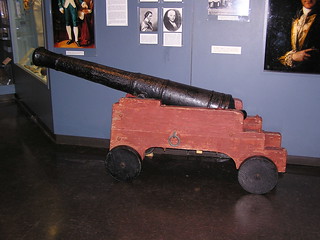
|
It isn't clear whether the gun would have still been present at White Point Garden in 1981.
|
| 3) The Pirate Monument |
This is a historical monument in the pathway on the north side of the park commemorating the execution of Stede Bonnet and his pirate crew in 1718:

|
The execution of the crew took place on November 8th, 1718. This might be what Verse 6 is referencing when it says "on the eighth a scene Where law defended."
(Presumably the hanging of pirates could be seen as a defense of the rule of law.)
Note that the marker only says "the autumn of 1718" and doesn't give an exact date. If this monument is the correct reference for the verse, it means that Preiss must have done some additional research on the history of the event. |
| 4) Steps to the High Battery |
South Battery and East Battery are two streets bordering the park. Where they meet at the northeast corner of the park there is a set of steps leading up to the High Battery, where people can walk along the seawall. The photo below on the right was taken from the top of the steps looking northwest at the Louis DeSaussure House.
 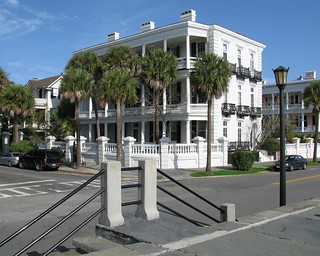 |
The steps have attracted attention from many searchers over the years because they are one of the few landmarks along the High Battery.
The Louis DeSaussure House is often mentioned as another candidate for the "white house" in Verse 6.
|
| 5) The Keokuk Gun |
Of all the weapons on display in White Point Garden, this 11-inch cannon at the northeast corner of the park probably has the most interesting history. It was originally mounted on the USS Keokuk, an ironclad Union warship that was launched in New York in December of 1862. After initial testing, the Keokuk left New York in March of 1863 and went south to join the battle of Charleston harbor. Unfortunately for the Union sailors, a series of unsuccessful naval maneuvers on the afternoon of April 7 left the ship positioned only 600 yards from Fort Sumter, where it was a sitting duck for the Confederate gunners. The Keokuk was hit by about 90 projectiles in the space of half an hour and, as a result, sank the next morning off the southern end of Morris Island. The ship's entire period of active service had lasted only a month.
After the sinking, the Union forces decided that the guns of the Keokuk were "unsalvageable" and they abandoned the underwater wreck. The Confederate forces, however, were in more desperate need of heavy weapons and they decided to try a risky and unorthodox salvage operation. Working night after night at low tide in complete darkness, a group of men swam underwater with hand tools to cut open the ship and free the guns. When the cannons were finally detached from the ship, a barge was towed into place and each of the 16,000-pound guns was hoisted to the surface and returned to shore. The entire operation took two and a half weeks and went undetected by the Union ships blockading the harbor less than a mile away.
After the Civil War, one of the two Keokuk guns disappeared and was likely sold for scrap metal, but the surviving gun was placed at White Point Garden in 1899.
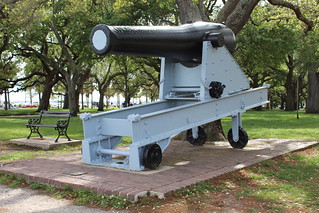
|
|
| 6) Former Site of the Raft Torpedo |
Just south of the Keokuk gun, the Post and Courier reports that there was once "a stumpy explosive that served as an example of crude torpedoes used during the Civil War. The bombs were mounted then on rafts, which were floated in the harbor to await the passing of an enemy ship." The raft torpedo was moved from the park to the Charleston Museum sometime before 2001.
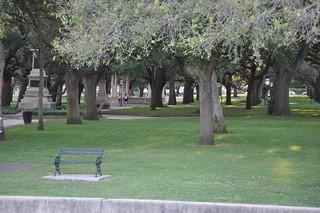 |
It isn't clear whether the raft torpedo exhibit was present in the park in 1981.
|
7) 10-inch Columbiad (1 of 2)
|
One of two columbiads that were part of the Confederate artillery at Fort Sumter and drew heavy bombardment from Union troops hoping to neutralize the fort. According to Wikipedia, "The ten-inch columbiad weighed 15,400 pounds and hefted a 128-pound shell to 4,800 yards or solid shot to 5,600 yards. These cast iron weapons were typically mounted on seacoast carriages designed to recoil up a slightly inclined set of "rails" or wooden beams. The mounted columbiad could pivot left or right on a traversing rail."
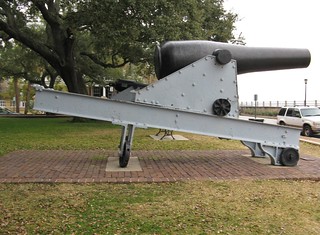 |
This long gun and its partner on the south side of the path are the most likely pair of armaments for the reference to a "pair of arms extended" in Verse 6.
|
8) The USS Maine Capstan (gone now)
|
This capstan, a metal drum used for raising anchors, was part of the USS Maine, a battleship sunk at the harbor in Havana, Cuba in 1898. The sinking claimed the lives of 258 sailors and led directly to the Spanish-American War, a total victory that helped signal the rise of the United States as an international power. The capstan was originally placed at Hampton Park, where it was ill-tended and vandalized. It was moved to White Point Garden in 1927. The capstan was replaced by a statue of William Moultrie in 2006.

There were bronze plaques on three of the four sides of the base holding up the capstan.
East side:
Capstan of
U.S.S. Maine
Destroyed in Havana Harbor
By External Explosion
At 9:40 P.M. February 15th, 1898
With the Loss of 266 Lives
South side:
Removed to this site
July 15th, 1927
Through the efforts of
Victor Blue Camp
United Spanish War Veterans
North side:
Presented by
The Navy Department
To the City of Charleston
Through the Courtesy of
U.S. Senator Benjamin R. Tillman
May, 1913
|
The line in Verse 6 about "May 1913" could be a reference to the capstan, which was given to the city of Charleston in May 1913. |
9) 10-inch Columbiad (2 of 2)
|
The other matching cannon from the Confederate artillery at Fort Sumter. This columbiad is not mounted in the same way as the north columbiad and it doesn't seem to be photographed as often.

|
|
10) The Fort Sumter Monument
|
This monument commemorates the valor of the Confederate defenders of Fort Sumter, who held the critical outpost for more than two years under intense bombardment. The 25-foot-tall monument was unveiled in 1932. According to sculptor Herman A. MacNeil, the idea behind the monument was that "the stalwart youth, standing in front with sword and shield symbolizes by his attitude the defense not only of the fort, but also of the fair city behind the fort in which are his most prized possessions, wife and family. And she, the wife, glorified into an Athena-like woman, unafraid, stands behind him with arms outstretched toward the fort, thus creating an inseparable union of the city and Fort Sumter ... " The granite pedestal holding the statue is etched with relief carvings of the soldiers.
  |
The sculptor's intention to show the woman "with arms outstretched toward the fort" is sometimes considered by searchers to be a possible link to the "arms extended" line in Verse 6.
Alternatively, this monument is sometimes paired with the Fort Moultrie Monument (#15) because each monument is seen to have one arm particularly extended.
The relief carvings on the side of monument are stylistically very similar to the birthmark on the lion's forehead in Image 2.
|
11) The BATTERY 3 Survey Disk
|
On the edge of the High Battery, just across East Battery from the Fort Sumter Monument, there is a small metal survey disk embedded in the wall. The disk has been there since at least 1933 and is now a waymarking location.

|
Searchers have been interested in the disk for the same reason that they have been interested in the stairs: there are very few landmarks that Preiss could have used along the High Battery.
|
12) The 7-inch Brooke Rifle
|
The Brooke rifle was a large gun invented by John Mercer Brooke, a Confederate officer in the U.S. Civil War. The rifle is recognizable by having one or more thick bands of wrought iron wrapped around the breech end of the cast iron barrel. This particular Brooke rifle was manufactured at Selma, Alabama in 1864. It was later found at Fort Johnson and was brought to Charleston in 1900.
 |
This is another gun that could (partially) fit the reference to a "pair of arms extended" in Verse 6. But the 13-inch mortar that is paired across the path (see #14 below) has a very short barrel and wouldn't be a likely candidate for "arms extended."
|
13) The Fake
|
What looks like a historic weapon is actually a clever forgery intended to mimic the authentic British 4-pound gun that once sat opposite it at the north end of the park.
How did it get there: The fake was born during a conflict involving the real cannon, which was buried in the middle of nearby Longitude Lane for decades. The city determined that the cannon, which dates to the Revolutionary War, should be displayed at White Point Garden. But Longitude Lane residents objected, forcing a dispute that ended only when city workers moved the cannon in the middle of the night in 1933. To defuse their anger, a practical joker decided to create a fake cannon that could be placed back at Longitude Lane. As it happens, they didn't want it, and it, too, was placed at the Battery. For years, many were fooled. But the giveaway is that the cannon was cast around a pipe to avoid the difficulty of drilling out the center. Problem is, the cast iron pipe used in the process would never have been used at the time the cannon was purportedly made.

|
|
| 14) 13-inch mortar #1 |
The first of four identical pieces of heavy artillery dating to the Civil War. Each of the guns weighs approximately 17,000 pounds and could fire a 200-plus pound shell nearly three miles. All were Union weapons, and similar guns were used against Fort Sumter. These three guns were made in Pittsburgh in the early 1860s. They have been in the park since 1901.
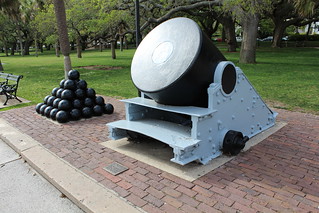 |
Like all the guns in the park, the mortars are painted black with a white filling in the barrel. The pattern at the end of the gun is very similar to the dots on the butterfly's wings in Image 2. There's also a possible resemblance between the shapes on the wings and the stacks of cannonballs.
|
| 15) The Fort Moultrie Monument |
This monument commemorates the successful defense of Sullivan's Island - and of Charleston - against an attack by the British on June 28, 1776, during the Revolutionary War. The monument portrays Sgt. William Jasper, who became a South Carolina legend after he raised a fallen flag to demonstrate the heart of the Fort Moultrie's defenders. The battle was a complete victory for the patriots, as a force commanded by Gen. William Moultrie routed the attack, suffering just 37 casualties to more than 200 for the British. Often referred to as the Sgt. Jasper Monument, the original intent was to honor all the defenders of the fort.
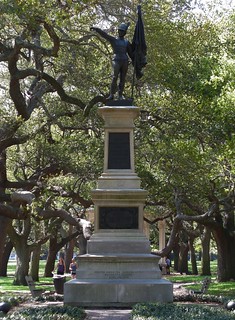 |
|
| 16) The Simms Monument |
This memorial commemorates William Gilmore Simms, a lawyer and historian who also wrote numerous novels popular for their use of local details. Simms also wrote a history of South Carolina that served as a standard school textbook until well into the 20th century. Simms was born in Charleston in 1806. The monument was erected in 1879, on the ninth anniversary of his death.
 |
|
| 17) Hunley Monument |
This 1899 monument commemorates the bravery of the several crews of the Hunley submarine, which sank often during practice runs before meeting its final end after successfully attacking the federal ship Housatonic. According to the Post and Courier, "The monument's location at the edge of South Battery Street has presented problems - the granite block has been struck several times by cars."
 |
There are fountains on the sides of this monument that may relate to the line in Verse 6 that tells searchers to "Hear the cool, clear song of water."
|
| 18) The M.F. Williams Memorial Bandstand |
The bandstand is named after Martha Fort Williams. Williams' daughter paid for the structure in her honor. Now largely a place to get out of the sun, the large gazebo once served as a bandstand. Concerts at White Point Garden were frequent during the first few decades of the 20th century, as hundreds of music lovers would pack the park, but the practice faded by 1930.
Built: 1907. Opened on Carolina Day - June 28 - in 1907 with a performance by the Metz Military Band.
 |
The bandstand could somehow be connected to the line in Verse 6 that tells searchers to "Stand and listen to the birds," but the connection seems weak. |
| 19) 13-inch mortar #2 |
See #14 above.
|
|
| 20) 13-inch mortar #3 |
See #14 above.
|
|
| 21) Rapid-fire gun |
This piece might have been seized from a Spanish ship during the Spanish-American War as a trophy. It features five barrels and would have been mounted to the boat. It's not clear how long the piece has been in the park, although the gun was given to the city in 1937 by the American Legion.

|
|
| 22) The Little Dancer |
The fountain, created by Charleston sculptor Willard Hirsch, was installed in 1962 and was intended to honor - and, set low, to provide cool water to - the city's children. The original sculpture has served for the model for several castings now found across the country.
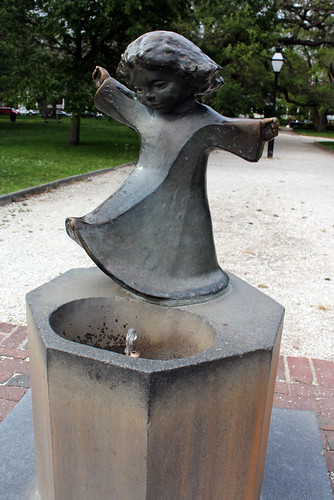 |
|
| 23) 13-inch mortar #4 |
See #14 above.
|
|
| 24) The Amberjack Memorial |
This 1970 monument honors the crew of the USS Amberjack submarine, during World War II, as well as the crews of the 51 other American subs lost during the war. The Amberjack sunk or damaged several Japanese vessels before being sunk in 1943.
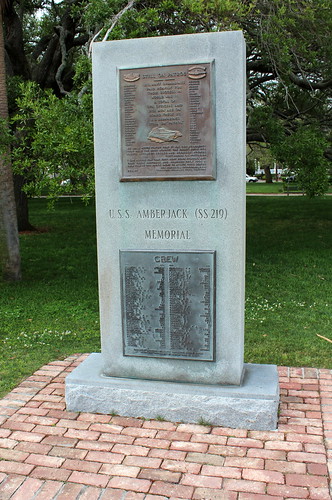 |
|
| 25) The Hobson Monument |
This 1954 monument commemorates one of the U.S. Navy's worst disasters, the collision of the USS Hobson, a destroyer, and the USS Wasp aircraft carrier in 1952. The Wasp cut the Hobson in half, killing 176 seamen. The Hobson had a Charleston connection, having been built at the Charleston Naval Shipyard and stationed in Charleston before the disaster.
The memorial is made of red granite and has a sundial on one side. The stones arranged around it come from the 38 home states of the men who died.
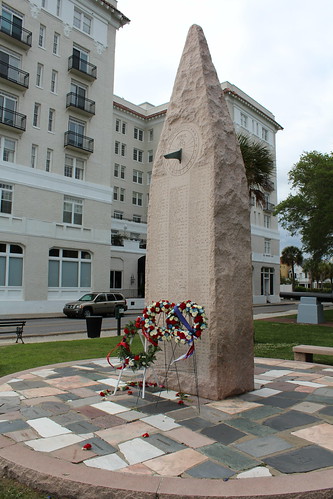
|
|
| 26) World War I howitzer |
This is the newest gun at White Point Garden, made in 1918 by the Bethlehem Steel Company. Its history is unclear, but similar howitzers are relatively rare today.

|
|
| 27) French cannon |
This four-pound cannon apparently was made in France and might have been used during the Revolutionary War. This and two similar guns were dug up near Camden. It likely was placed at White Point Garden during the early 1900s.

|
|
| 28) Former site of 12-pound howitzer |
The empty stand at the intersection of King Street and South Battery used to hold a bronze howitzer cast in Massachusetts in 1851. At some point prior to 1999, the piece was moved to the Charleston Museum to better preserve it.
 |
It isn't clear whether the gun would have been present in the park in 1981.
|
|
Sources:
- A Walk in the Parks: The Definitive Guidebook to Monuments in Charleston's Major Downtown Parks-- Including White Point Garden, Marion Square, Waterfront Park, and Washington Square by John R. Young, 2010
- "A guide to the monuments and history of White Point," by Jason Hardin, published in The (Charleston, SC) Post and Courier on September 2, 2001.
- The city of Charleston Parks Department
- "The Battery, Charleston, South Carolina" - a booklet describing the history and monuments of White Point Garden written by Charleston author Warren Ripley and published by the Evening Post Publishing Co. in 1977. The booklet had an initial printing of 5,000 copies in 1977 and a second printing of an additional 5,000 copies in 1981. It's possible that Preiss used a copy of this booklet as a reference when he was doing research for this puzzle.
|
|
Comments (0)
You don't have permission to comment on this page.